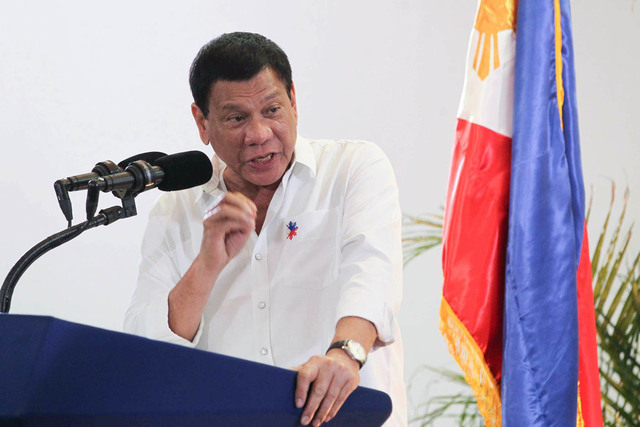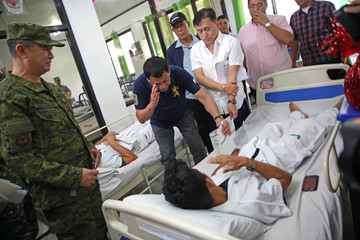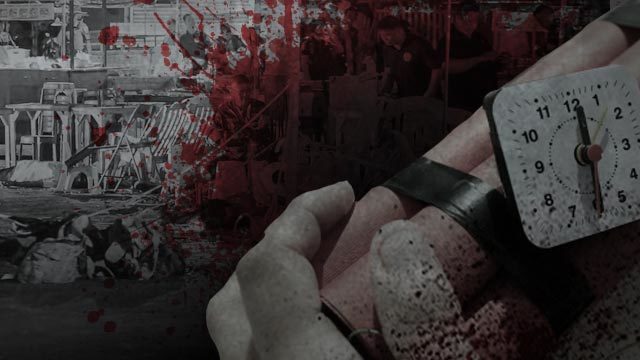From Rappler (Dec 17):
MAP: Where did violence in PH erupt in past 6 months? (By Addie Pobre and Cathrine Gonzales(
Bomb scares, explosions, public officials killed – Rappler compiles a list of the violent incidents that have erupted as of mid-December in the Philippines
 Aside from the administration's bloody crackdown on illegal drugs – which has racked up over 6,000 victims – there's been a number of violent incidents in recent months adding to the body count of Filipinos killed.
At least 5 public officials have been killed under varying circumstances. Bomb scares were reported in different parts of the country – with some reported hoaxes happening on the same day. In Southern Philippines, there have been at least 3 blasts reported – including the deadly Davao City bombing attack, which left 15 people dead and over 60 others injured.
Here's a list of violent incidents reported in the media in recent months, and where these have occurred. We will be constantly monitoring and updating this list.
Aside from the administration's bloody crackdown on illegal drugs – which has racked up over 6,000 victims – there's been a number of violent incidents in recent months adding to the body count of Filipinos killed.
At least 5 public officials have been killed under varying circumstances. Bomb scares were reported in different parts of the country – with some reported hoaxes happening on the same day. In Southern Philippines, there have been at least 3 blasts reported – including the deadly Davao City bombing attack, which left 15 people dead and over 60 others injured.
Here's a list of violent incidents reported in the media in recent months, and where these have occurred. We will be constantly monitoring and updating this list.
Blasts, attempted bombings
September 2, 2016: Explosion at the Roxas Night Market, Davao City
An improvised explosive device (IED) caused the
deadly blast that left 15 people dead and over 60 injured. The incident prompted President Rodrigo Duterte to declare a nationwide state of lawlessness in response to the deadly attack. The Abu Sayyaf earlier claimed responsibility for the attack, but the group later denied this. In October, 3 suspects – members of the Maute group – were
arrested in relation to the attack.
Four more suspects were arrested later in the month.
September 3, 2016: Two explosions in North and South Cotabato
A day after the Davao bombing, a transmission tower of the National Grid Corporation of the Philippines in North Cotabato was bombed, damaging the tower. In South Cotabato, a grenade was lobbed near the house of Polomolok Vice Mayor Elias Jovero, damaging the ceiling and glass windows of the house. No one was hurt in the incident.
September 26, 2016: Blast in a Muslim compound in Quezon City
Four policemen and 3 barangay personnel were injured after unidentified assailants
threw a hand grenade at the victims, who were about to patrol the Al Salaam Mosque Compound in Quezon City. Police said drug syndicates may be behind the attack, after 217 suspects were arrested in two raids.
November 28, 2016: IED found near the US embassy
Witnesses reported a "suspicious package" being dropped off by a person riding a taxi around 2 am. The IED was found inside a carton box on the sidewalk of Roxas Boulevard, near the US embassy. The explosive was composed of a blasting cap, a detonator, a cellular phone, and a 9-volt battery. Police said the box also contained an 81-mm mortar, similar to the one found in the September explosion at a Davao night market. Police chief Director General Ronald dela Rosa said the bomb try was an "attempted act of terrorism” by the Lanao del Sur-based Maute terror group, which has pledged allegiance to the Islamic State (ISIS).
December 7, 2016: Blast in Iligan City
An unidentified individual threw a grenade at the public plaza in Iligan City,
injuring 4 bystanders. Iligan City is an hour away from Marawi City, where law enforcers are tracking down the Maute terror group.
Bomb threats
September 2016:
- A bomb threat allegedly issued by the Abu Sayyaf, supposedly targeted the University of the Philippines-Diliman in Quezon City.
- Baliuag University in Bulacan cancelled classes after receiving a bomb threat – the second it received in September.
- Schools near Malacañang Palace received bomb threats, but police found no bombs in the schools.
- Schools in Quezon City as well as several government offices received bomb threats, which turned out to be hoaxes.
- The Makati City Hall was evacuated after a caller warned of a bomb supposedly planted inside the building.
- Just days after the deadly Davao bombing, 3 schools in Davao City, as well as several schools in parts of Luzon, received bomb threats.
- The Ninoy Aquino International Airport received a message warning that Manila was the next target of ISIS.
October 2016
November 2016
December 2016
Public officials killed
October 27, 2016: Erwin Sarmiento, barangay councilor of Jubay in Liloan town, Cebu, was
gunned down by two motorcycle-riding men. Police said the killing may be related to Sarmiento's involvement in the illegal drug trade.
October 28, 2016: Mayor Samsudin Dimaukom of Datu Saudi Ampatuan town in Maguindanao and 9 others were killed in an
alleged shootout with state operatives in Makilala, North Cotabato. The Maguindanao mayor, who was named in the drug list of President Duterte, and his convoy were flagged down at a checkpoint “based on information that the group will transport illegal drugs to Maguindanao and Cotabato area.”
November 5, 2016: Albuera mayor Rolando Espinosa Sr was killed inside his cell at the Leyte Sub-Provincial Jail in Baybay City, in a
supposed shootout with personnel from the Criminal Investigation and Detection Group (CIDG). Espinosa allegedly resisted arrest when the CIDG tried to serve a search warrant in connection with illegal possession of firearms. The National Bureau of Investigation, however, said the incident was a
"rubout."
November 17, 2016: Art Lachica, the Bureau of Customs' Deputy Commissioner for its Internal Administration Group, was
shot on España Boulevard in Manila, sustaining multiple gunshot wounds to the chest.
November 21, 2016: Jonas Amora, Bureau of Internal Revenue regional director of the Makati City Revenue Region 8, was on his way to work when two motorcycle-riding individuals
shot at him. The incident occurred at the corner of Major Santos Dizon and Katipunan Avenue in Barangay Escopa 2, Quezon City.
What happened in the past 6 months?
It was the September explosion at the Davao City night market that seemed to have set off a flurry of bomb threats and hoaxes in several schools and government agencies in various parts of the country. Some of these hoaxes targeted several institutions and were made on the same day.
While many of the bomb scares happened in Metro Manila, only two actual incidents of an explosion or a bombing attempt have occurred there: the September blast in a Muslim compound in Quezon City, and the foiled bombing attempt at the US embassy in November.
Meanwhile, the killings of public officials were distributed around the country: 2 incidents in Luzon, 2 in the Visayas, and one in Mindanao.
The Davao bombing was also the catalyst for Duterte's declaration of a
state of lawlessness, putting the entire country under a
state of national emergency.
In declaring a state of lawlessness, the President emphasized that it was not martial law and that it does not involve the suspension of the writ of habeas corpus. It only meant that checkpoints would be set up and more law enforcers would be deployed.
Yet despite his assurance – aimed at easing critics' fears of another martial law regime – Duterte would later issue warnings that seemed to contradict his earlier pronouncement.
In October, a month after declaring a state of national emergency, he admitted that he was
tempted to declare martial law supposedly because of the extent of the Philippines' drug problem. But he added that he settled on declaring a state of lawlessness instead because he was told that martial law was "not feasible."
In November, he warned that if lawlessness persists, he would
suspend the writ of habeas corpus, which would allow security forces to conduct warrantless arrest.
In early December, days after the foiled bombing attempt at the US embassy, the Philippine National Police said that it is on
"terror alert level 3." Under the Terror Threat Advisory System of the Anti-Terrorism Council, an area is placed under Threat Level 3 "when a terrorist attack is a strong possibility within a short period of time.”
[Addie Pobre and Cathrine Gonzales are Rappler interns studying journalism at Polytechnic University of the Philippines]
http://www.rappler.com/newsbreak/iq/155345-map-violent-incidents-philippines-2016








